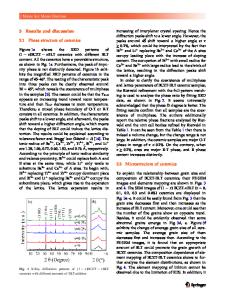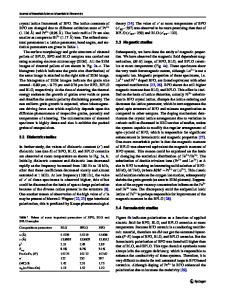Influence of Ba 2+ Doping on Structural and Electrical Transport Properties of YMnO 3 Ceramics
- PDF / 1,812,517 Bytes
- 9 Pages / 595.276 x 790.866 pts Page_size
- 18 Downloads / 460 Views
ORIGINAL PAPER
Influence of Ba2+ Doping on Structural and Electrical Transport Properties of YMnO3 Ceramics Jyoti Shukla 1
&
Ashutosh Mishra 1
Received: 6 August 2020 / Accepted: 18 September 2020 # Springer Science+Business Media, LLC, part of Springer Nature 2020
Abstract The pristine and barium (Ba2+) doped YMnO3 (Y1−xBaxMnO3; x = 0.00 and 0.05) ceramic samples were synthesized through the solid-state reaction method. The X-ray diffraction, Raman spectroscopy, and scanning electron microscopy were performed for the structural and morphological studies. The electrical transport properties were investigated using dielectric and modulus spectroscopy. The XRD patterns of the titled ceramics have shown the monophasic hexagonal structure having P63cm space group symmetry. The average crystallite size is found to decrease on partial substitution of Ba2+ cation. Raman spectroscopy was performed to observe the local disorder and variation in the modes with the introduction of dopant in the pristine ceramic. The surface morphology displays the formation of non-uniform grains in the ceramics. The dielectric spectroscopy reveals a decreasing trend in both the dielectric constant and dissipation factor with increasing frequency. It indicates the significant role played by the space charge polarization. The electrical modulus study of the ceramics was also performed to explore the electrical transport phenomenon. The present study reports the enhanced dielectric nature of doped materials. Keywords Multiferroics . Manganites . XRD . Electrical conductivity . Electrical modulus
1 Introduction The rare-earth manganites (RMnO3) are typically found multiferroic in nature. It possesses cross-coupling between the electrical and magnetic order, which is coined as magneto-electric coupling [1, 2]. These materials mostly crystallize into more than one phase based on the ionic radii of rare-earth elements and the doping elements. Normally, the smaller ionic radii favor the hexagonal phase and the greater ionic radii favor the orthorhombic phase. In hexagonal YMnO3, the layers of Y3+ ions isolate the corner shared MO5 trigonal bipyramids. Here, each manganese (Mn3+) ion is enclosed by three in-plane oxygen ions and two apical oxygen ions. A net electric polarization in YMnO3 results due to the buckling of MnO5 polyhedra, which is usually accompanied by the displacement of Y3+ ions [3, 4].
* Jyoti Shukla [email protected] 1
Materials Science Laboratory, School of Physics, Vigyan Bhawan, Devi Ahilya University, Khandwa Road, Indore 452001, India
Yttrium manganese oxide (YMnO3) is broadly studied owing to its simple crystal structure and magnetic order that promotes ease of understanding the complex physics of multiferroicity. YMnO3 has high ferroelectric transition temperature (Tc≈ 900 K) and low antiferromagnetic transition temperature (TN ≈ 70 K) [4–6]. The potential applications of YMnO3 are found in data storage devices, but they also hold promising applications in the area of magnetic field sensors, actuators, as well a
Data Loading...











